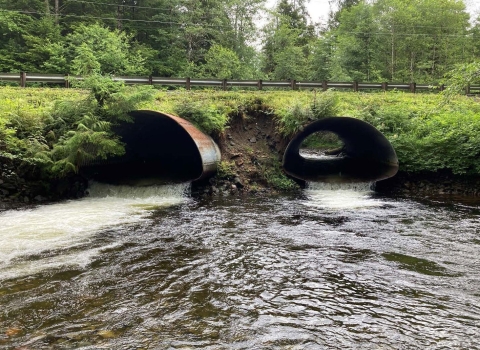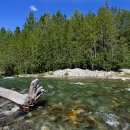States
AlaskaSalmon are the backbone of the culture and economy of Southeast Alaska. Tribal, agency, and community partners are building partnerships to restore passage for salmonids across the landscape of Tribal, federal, and private lands in the region. This transformational project aims to employ and empower Tribes and local communities in restoration efforts, including training, job experience, and capacity building for Tribally led fish passage fish passage
Fish passage is the ability of fish or other aquatic species to move freely throughout their life to find food, reproduce, and complete their natural migration cycles. Millions of barriers to fish passage across the country are fragmenting habitat and leading to species declines. The U.S. Fish and Wildlife Service's National Fish Passage Program is working to reconnect watersheds to benefit both wildlife and people.
Learn more about fish passage restoration teams. As more barriers are assessed and prioritized by partners across the region, this work will continue to provide opportunities to employ local people and bolster fish populations that southeast Alaskans so heavily depend upon. Additionally, removing these barriers to fish passage will reduce flooding risk to landowners and strengthen resilience of critical transportation infrastructure.
Project Quick Facts
- Location: Alaska
- BIL Investments to date: $35,000,000
- Total Restoration Costs: $50,000,000+
- Type of Barriers: Culverts, Dams
- Stream Miles Reopened: 35+
- Non-Federal Partners Include: Southeast Alaska Watershed Coalition, Trout Unlimited, Southeast Alaska Fish Habitat Partnership, State of Alaska, Klawock Indigenous Stewards Forest Partnership, Ketchikan Indian Community, Kootznoowoo Inc., Yakutat Tlingit Tribe, Keex Kwáan Community Forest Partnership, Prince of Wales Tribal Conservation District, Sealaska Corporation, Shaan Seet, Inc., Metlakatla Indian Community, Organized Village of Kake, and Klawock-Heenya Corporation
- Federal Agencies Invested to Date: U.S. Fish and Wildlife Service, National Marine Fisheries Service, Federal Highway Administration, U.S. Forest Service, Bureau of Reclamation
Removing Barriers to Success
Work extending beyond the scope of the currently funded project includes a comprehensive assessment and prioritization of barriers across Southeast Alaska. Additional capacity building will also provide local communities the tools needed to inventory, assess, prioritize, design, and implement additional projects across the region.
The Importance of Transformational Fish Passage Projects
This project is one of over 70 grand-scale, community-centric restoration projects, identified by the Federal Interagency Fish Passage Task Force, that not only rejuvenate ecosystems but also bolster the climate resilience and economies of communities across the country. Learn more about these ground breaking projects in our Reviving Rivers, Reconnecting Communities story map.
The National Fish Passage Program: Leaders in Building Bridges and Fostering Connections
The National Fish Passage Program is a national leader connecting watersheds and people. The program has decades of experience implementing infrastructure projects with partners. Fish passage project proposals can be initiated by any individual, organization, government, or agency. However, proposals must be submitted and completed in cooperation with a Fish and Wildlife Conservation Office. (Please note that fish passage projects being used for federal or state compensatory mitigation or required by existing federal or state regulatory programs are not eligible for funding through the National Fish Passage Program.)
CONTACT A FISH PASSAGE COORDINATOR IN YOUR AREA TO GET STARTED.
200 Million Dollar Investment in Rivers, Wildlife, and Communities
Clean free-flowing waterways are vital to wildlife, people, and ecosystems. But across the country, millions of barriers fragment rivers, block fish migration, and put communities at higher risk to flooding. The Bipartisan Infrastructure Law Bipartisan Infrastructure Law
The Bipartisan Infrastructure Law (BIL) is a once-in-a-generation investment in the nation’s infrastructure and economic competitiveness. We were directly appropriated $455 million over five years in BIL funds for programs related to the President’s America the Beautiful initiative.
Learn more about Bipartisan Infrastructure Law , signed in November 2021, included $200 million for restoring fish and wildlife passage by removing in-stream barriers and providing technical assistance under the National Fish Passage Program.




